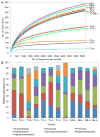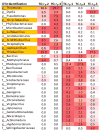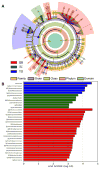Treatment impacts on temporal microbial community dynamics during phytostabilization of acid-generating mine tailings in semiarid regions
- PMID: 29132003
- PMCID: PMC5773348
- DOI: 10.1016/j.scitotenv.2017.11.010
Treatment impacts on temporal microbial community dynamics during phytostabilization of acid-generating mine tailings in semiarid regions
Abstract
Direct revegetation, or phytostabilization, is a containment strategy for contaminant metals associated with mine tailings in semiarid regions. The weathering of sulfide ore-derived tailings frequently drives acidification that inhibits plant establishment resulting in materials prone to wind and water dispersal. The specific objective of this study was to associate pyritic mine waste acidification, characterized through pore-water chemistry analysis, with dynamic changes in microbial community diversity and phylogenetic composition, and to evaluate the influence of different treatment strategies on the control of acidification dynamics. Samples were collected from a highly instrumented one-year mesocosm study that included the following treatments: 1) unamended tailings control; 2) tailings amended with 15% compost; and 3) the 15% compost-amended tailings planted with Atriplex lentiformis. Tailings samples were collected at 0, 3, 6 and 12months and pore water chemistry was monitored as an indicator of acidification and weathering processes. Results confirmed that the acidification process for pyritic mine tailings is associated with a temporal progression of bacterial and archaeal phylotypes from pH sensitive Thiobacillus and Thiomonas to communities dominated by Leptospirillum and Ferroplasma. Pore-water chemistry indicated that weathering rates were highest when Leptospirillum was most abundant. The planted treatment was most successful in disrupting the successional evolution of the Fe/S-oxidizing community. Plant establishment stimulated growth of plant-growth-promoting heterotrophic phylotypes and controlled the proliferation of lithoautotrophic Fe/S-oxidizers. The results suggest the potential for eco-engineering a microbial inoculum to stimulate plant establishment and inhibit proliferation of the most efficient Fe/S-oxidizing phylotypes.
Keywords: Iron oxidation; Microbial diversity; Mine reclamation; Plant growth promoting bacteria; Sulfur oxidation.
Copyright © 2017 Elsevier B.V. All rights reserved.
Conflict of interest statement
The authors declare no conflict of interest.
Figures




Similar articles
-
Environmental factors influencing the structural dynamics of soil microbial communities during assisted phytostabilization of acid-generating mine tailings: a mesocosm experiment.Sci Total Environ. 2014 Dec 1;500-501:314-24. doi: 10.1016/j.scitotenv.2014.08.107. Epub 2014 Sep 18. Sci Total Environ. 2014. PMID: 25237788 Free PMC article.
-
Phytostabilization potential of quailbush for mine tailings: growth, metal accumulation, and microbial community changes.J Environ Qual. 2007 Jan 9;36(1):245-53. doi: 10.2134/jeq2006.0197. Print 2007 Jan-Feb. J Environ Qual. 2007. PMID: 17215233
-
Abundance and Activity of 16S rRNA, AmoA and NifH Bacterial Genes During Assisted Phytostabilization of Mine Tailings.Int J Phytoremediation. 2015;17(1-6):493-502. doi: 10.1080/15226514.2014.935284. Int J Phytoremediation. 2015. PMID: 25495940 Free PMC article.
-
Distinguishing reclamation, revegetation and phytoremediation, and the importance of geochemical processes in the reclamation of sulfidic mine tailings: A review.Chemosphere. 2020 Aug;252:126446. doi: 10.1016/j.chemosphere.2020.126446. Epub 2020 Mar 7. Chemosphere. 2020. PMID: 32182510 Review.
-
Phytostabilization of mine tailings in arid and semiarid environments--an emerging remediation technology.Environ Health Perspect. 2008 Mar;116(3):278-83. doi: 10.1289/ehp.10608. Environ Health Perspect. 2008. PMID: 18335091 Free PMC article. Review.
Cited by
-
Arsenic and iron speciation and mobilization during phytostabilization of pyritic mine tailings.Geochim Cosmochim Acta. 2020 Oct 1;286:306-323. doi: 10.1016/j.gca.2020.07.001. Epub 2020 Jul 11. Geochim Cosmochim Acta. 2020. PMID: 33071297 Free PMC article.
-
Isolation and Genome Analysis of an Amoeba-Associated Bacterium Dyella terrae Strain Ely Copper Mine From Acid Rock Drainage in Vermont, United States.Front Microbiol. 2022 May 23;13:856908. doi: 10.3389/fmicb.2022.856908. eCollection 2022. Front Microbiol. 2022. PMID: 35677904 Free PMC article.
-
Extraction of heavy metals from copper tailings by ryegrass (Lolium perenne L.) with the assistance of degradable chelating agents.Sci Rep. 2024 Apr 1;14(1):7663. doi: 10.1038/s41598-024-58486-w. Sci Rep. 2024. PMID: 38561404 Free PMC article.
-
The effect of biogeochemical redox oscillations on arsenic release from legacy mine tailings.Geochim Cosmochim Acta. 2023 Nov 1;360:192-206. doi: 10.1016/j.gca.2023.09.012. Epub 2023 Sep 16. Geochim Cosmochim Acta. 2023. PMID: 37928745 Free PMC article.
-
Zinc accumulation in Atriplex lentiformis is driven by plant genes and the soil microbiome.Sci Total Environ. 2023 Nov 15;899:165667. doi: 10.1016/j.scitotenv.2023.165667. Epub 2023 Jul 20. Sci Total Environ. 2023. PMID: 37478925 Free PMC article.
References
-
- Akcil A, Koldas S. Acid Mine Drainage (AMD): causes, treatment and case studies. J Clean Prod. 2006;14:1139–1145.
-
- Anandham R, Indiragandhi P, Madhaiyan M, Ryu KY, Jee HJ, Sa TM. Chemolithoautotrophic oxidation of thiosulfate and phylogenetic distribution of sulfur oxidation gene (soxB) in rhizobacteria isolated from crop plants. Res Microbiol. 2008;159:579–589. - PubMed
-
- Anandham R, Kwon SW, Gandhi PI, Kim SJ, Weon HY, Kim YS, et al. Dyella thiooxydans sp. nov., a facultatively chemolithotrophic, thiosulfate-oxidizing bacterium isolated from rhizosphere soil of sunflower (Helianthus annuus L.) Int J Syst Evol Microbiol. 2011;61:392–398. - PubMed
-
- Baker BJ, Banfield JF. Microbial communities in acid mine drainage. FEMS Microbiol Ecol. 2003;44:139–152. - PubMed
-
- Bashan Y, de-Bashan LE. Bacteria: Plant growth-promoting. In: Hillel D, editor. Encyclopedia of Soils in the Environment. 1. Oxford: Elsevier; 2005. pp. 103–115.
MeSH terms
Substances
Grants and funding
LinkOut - more resources
Full Text Sources
Other Literature Sources
Miscellaneous

